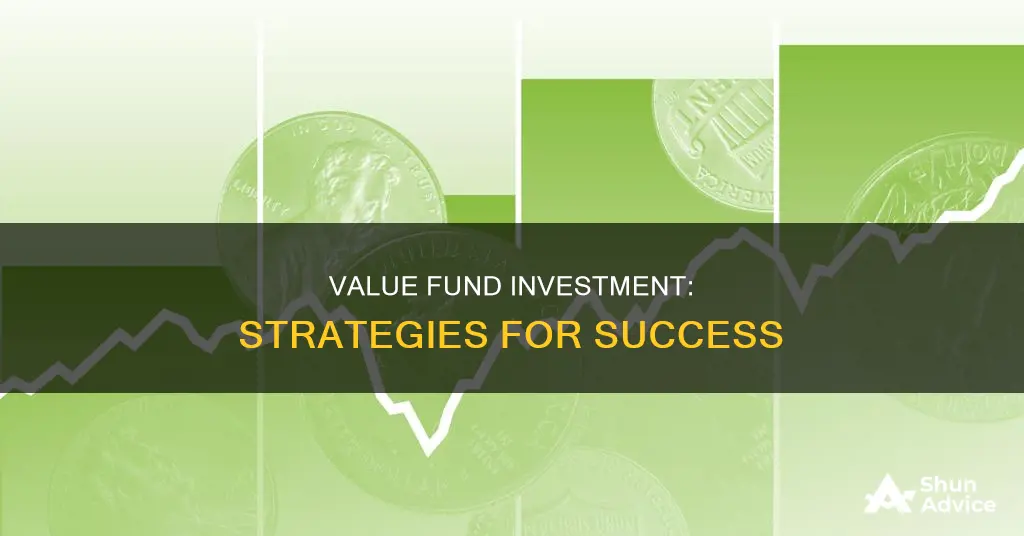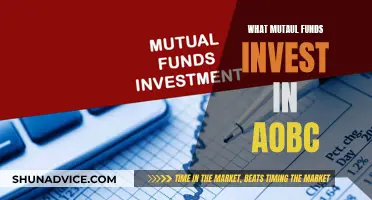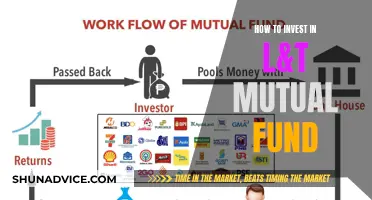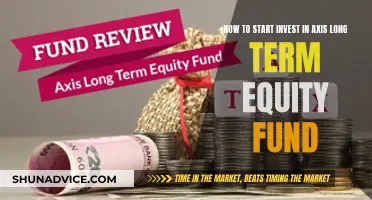
Value funds are a type of investment vehicle, such as an exchange-traded fund (ETF) or mutual fund, that focuses on investing in stocks that are undervalued based on their intrinsic value or fundamental characteristics. The underlying principle of value investing is to purchase stocks at a discount, hold them for the long term, and profit when their market price reflects their true value. This strategy is often associated with renowned investors like Warren Buffett and Benjamin Graham, who have successfully identified and invested in undervalued stocks. Value funds offer diversification and are generally considered a lower-risk option compared to growth stocks, especially when investing in stocks with predictable cash flows.
| Characteristics | Values |
|---|---|
| Type of investment strategy | Value funds are a type of investment strategy that focuses on investing in stocks that are undervalued based on fundamental characteristics. |
| Comparison to growth investing | Value investing is often contrasted with growth investing, which focuses on emerging companies with high growth potential. |
| Long-term investing | Value funds are typically used as long-term investing allocations with the potential to grow steadily over time. |
| Types of companies | Value stocks are frequently well-established companies that offer investors dividend payments. |
| Types of funds | Value funds can be in the form of exchange-traded funds (ETFs) or mutual funds. |
| Risk | Value investing is considered a low-risk strategy when done correctly, especially when investing in stocks with predictable cash flows. |
| Advantages | Value funds offer diversification, exposure to a range of value stocks, and the potential for higher dividend yields. |
| Famous proponents | Warren Buffett and Benjamin Graham are famous proponents of value investing. |
What You'll Learn

Understand the difference between value investing and growth investing
Value investing and growth investing are two distinct investment strategies. While value investing involves purchasing stocks that are undervalued or trading below their intrinsic or book value, growth investing focuses on companies with high growth prospects and above-average returns.
Value Investing
Value investors seek out hidden gems in the market: stocks with low prices but promising prospects. These stocks may be undervalued due to short-term events, such as public relations crises, or longer-term issues within their industry. Value investors buy these stocks, anticipating that their price will rebound once others recognise their potential. Value stocks typically have low price-to-earnings ratios and high dividend yields. The risk associated with value investing is that the stock price may not appreciate as expected.
Growth Investing
Growth investors, on the other hand, focus on companies that have demonstrated better-than-average growth in earnings, revenue, or other metrics and are expected to continue this trajectory. These companies are often leaders or emerging players in their respective industries. Growth stocks tend to have above-average price-to-earnings ratios and may offer low or no dividends as they reinvest their earnings for further expansion. The risk with growth investing is that any unforeseen events or setbacks could cause the stock's price to fall.
Key Differences
Value stocks are considered to be undervalued and priced lower than their intrinsic worth, while growth stocks are seen as overvalued and priced higher. Value stocks usually exhibit greater stability and lower volatility, whereas growth stocks are associated with higher risk and volatility. Value stocks often provide higher dividend yields, whereas growth stocks typically reinvest their earnings and offer lower or no dividends.
Historical Performance
When comparing the historical performance of value and growth stocks, it's important to consider the time horizon and the level of volatility and risk involved. Value stocks are generally considered to have lower risk and volatility as they are often found in larger, more established companies. Even if they don't reach the predicted target price, they may still offer some capital growth and dividend payouts. Growth stocks, on the other hand, tend to refrain from paying dividends and instead reinvest their earnings for expansion. As a result, growth stocks can experience higher probabilities of loss if the company fails to meet growth expectations.
Choosing Between Value and Growth Investing
The decision to invest in value or growth stocks depends on your financial goals, risk tolerance, and investment preferences. If you seek current income from your portfolio and prefer more stable stock prices, value investing may be more suitable. On the other hand, if you are comfortable with higher risk and volatility and are interested in long-term growth potential, growth investing might be the better choice.
Debt Fund Investment Guide for Indians
You may want to see also

Learn how to identify undervalued stocks
Value funds are a type of investment strategy that focuses on purchasing stocks that are undervalued based on fundamental analysis. The underlying premise is that once the market recognises the true value of these stocks, the share price will increase, and investors will profit from this increase.
Price-to-Earnings Ratio (P/E)
The P/E ratio is the most popular way to measure a company's value. It shows how much you would need to spend to make $1 in profit. A low P/E ratio could indicate that the stock is undervalued. The P/E ratio is calculated by dividing the price per share by the earnings per share (EPS).
Debt-Equity Ratio (D/E)
The D/E ratio measures a company's debt against its assets. A higher ratio could mean that the company relies more on lending than on funding from shareholders. However, this does not necessarily indicate that its stock is undervalued. To determine this, the company's D/E ratio should be compared to the average for its competitors, as a 'good' or 'bad' ratio varies by industry. The D/E ratio is calculated by dividing liabilities by stockholder equity.
Return on Equity (ROE)
ROE is a percentage that measures a company's profitability relative to its equity. A high ROE could suggest that the shares are undervalued because the company is generating substantial income compared to the amount of shareholder investment. ROE is calculated by dividing net income by shareholder equity.
Price-Earnings to Growth Ratio (PEG)
The PEG ratio examines the P/E ratio in relation to the percentage growth in annual EPS. A company with solid earnings and a low PEG ratio may indicate that its stock is undervalued. The PEG ratio is calculated by dividing the P/E ratio by the percentage growth in annual EPS.
Price-to-Book Ratio (P/B)
The P/B ratio assesses the current market price against the company's book value (assets minus liabilities) divided by the number of shares issued). A stock could be undervalued if the P/B ratio is lower than 1. The P/B ratio is calculated by dividing the market price per share by the book value per share.
Other Factors
When identifying undervalued stocks, it is also important to consider the broader context. For example, stocks can become undervalued due to negative press, economic shifts, political changes, or social factors. Additionally, the recognisability of the company and market crashes can also impact stock value.
It is crucial to gather relevant financial information and conduct thorough research before making investment decisions.
Small-Cap Growth Funds: Smart Investment, Big Returns
You may want to see also

Know the risks of value investing
Value investing is a low-to-medium-risk strategy, but as with any investment strategy, there is always a risk of loss. Here are some of the key risks associated with value investing:
- The risk of overpaying for stocks: Overpaying for a stock is one of the biggest risks for value investors. Buying a stock that is undervalued means your risk of losing money is reduced, even if the company doesn't perform well. Value investors try to build a margin of safety into their investments by purchasing stocks at around two-thirds of their intrinsic value.
- Market timing risk: Value investing requires a long-term perspective and patience. Investors need to be careful not to try and time the market, as there is a risk that the market may not recognize the true value of the stocks for an extended period. This could result in missing out on potential gains or experiencing losses.
- Economic risk: Undervalued stocks may be more sensitive to changes in economic conditions. For example, a recession could cause a decline in earnings for companies with weak fundamentals, leading to a drop in their stock price.
- Interest rate risk: Changes in interest rates can also impact the performance of the underlying stocks in a value fund. If interest rates rise, companies with high levels of debt may face increased interest expenses, which could lead to a decline in their earnings and stock price.
- Value trap: This occurs when a stock appears to be undervalued but continues to decline in price, with no improvement in fundamentals. This can happen when a company faces significant challenges such as declining revenue, earnings, or increased competition.
- Risk of loss: With any investment, there is no guarantee that you will get all your money back when you sell. Generally, lower-risk investments offer lower potential returns. If your objective is to grow your investment, you will need to accept a certain level of risk.
- Volatility: Volatility is a measure of how much an investment's value fluctuates over time. More volatile investments can offer the potential for greater returns, but also carry more risk. For example, equity values can change dramatically following individual events, and are generally more volatile than fixed-return investments like cash deposits.
- Counterparty or credit risk: Even when investing in what appears to be a safe option, such as a bond or cash deposit, there is a risk that you could lose money if the company issuing the investment is unable to repay its debts.
- Inflation risk: All investments are subject to inflation risk. Keeping your money in a savings account or fixed-term deposit may offer more certainty and security, but it increases your exposure to inflation risk as the returns may be lower than the rate of inflation.
- Fixed-term risk: Some investments require you to hold them for a fixed period, or give notice before withdrawing. This can result in opportunity risk, where you may find more lucrative investments but are unable to access your money. It can also create a risk if your circumstances change and you need to withdraw your investment.
- Marketability risk: In some cases, there may be no buyer available when you wish to sell your investment. This risk is greater for smaller companies with less-traded shares, and for certain bonds and structured products.
- Concentration risk: This occurs when your investments are too concentrated in one area, such as a single stock or industry. If that area declines in value due to a single event, your entire portfolio could be affected.
It is important to always thoroughly understand the risks associated with any investment before proceeding.
Invest in SBI Magnum Midcap: A Guide to Get Started
You may want to see also

Compare value funds with other types of funds
Value funds are a type of mutual fund that focuses on investing in stocks that are undervalued based on fundamental characteristics. They are often contrasted with growth investing, which focuses on emerging companies with high growth potential. Value funds are typically used as long-term investments and are associated with due diligence and patience.
Comparison with Other Types of Funds
Mutual Funds
Mutual funds are investment vehicles that pool money from multiple investors to purchase a diversified portfolio of stocks, bonds, or other securities. They are the most common type of fund and can be further categorized into stock funds, bond funds, index funds, money market funds, and ETFs. Mutual funds offer investors a professionally managed portfolio and potential benefits from economies of scale, while also spreading risk across multiple investments.
Closed-End Funds
Closed-end funds sell a fixed number of shares in an initial public offering (IPO). The shares then trade on the secondary market, and their price may be higher or lower than the fund's net asset value. Closed-end funds are less liquid than mutual funds, as investors typically rely on the secondary market to sell their shares. These funds may invest in a greater amount of illiquid securities.
Unit Investment Trusts (UITs)
UITs issue a fixed number of securities ("units") in a public offering. Investors can redeem these units at their approximate net asset value. UITs have a fixed termination date and do not actively trade their portfolio. Instead, they hold a static portfolio until termination, at which point the portfolio is liquidated, and proceeds are paid to investors.
Private Funds
Private funds are offered only to a limited number of financially sophisticated investors, rather than the general public. They avoid many of the regulatory and compliance obligations imposed on registered investment companies. Common types of private funds include hedge funds, private equity funds, and managed futures funds. Private funds are often organized in offshore jurisdictions for tax, regulatory, and marketing reasons.
Mutual Funds: Diversify Your Portfolio, Maximize Returns
You may want to see also

Find out how to get started with value funds
Value funds are a type of investment vehicle, such as an exchange-traded fund (ETF) or a mutual fund, that focuses on investing in stocks that are undervalued in price based on fundamental characteristics. Value funds are often associated with long-term investing and the potential for steady growth over time.
Understand Value Investing:
Value investing involves picking stocks that appear to be trading for less than their intrinsic or book value. Value investors believe that the market can underreact or overreact to news, resulting in stock price movements that do not reflect the company's long-term fundamentals. This creates an opportunity to profit by purchasing stocks at discounted prices.
Research and Analyse:
Value investors use financial analysis to identify stocks that are undervalued. They consider various metrics such as price-to-book (P/B), price-to-earnings (P/E), and free cash flow to determine if a stock is undervalued. It is important to thoroughly research and analyse a company's financial health and compare it to industry peers.
Evaluate Risk Tolerance:
Value investing, like any other investment strategy, carries the risk of loss. It is important to set a "margin of safety" based on your risk tolerance. This involves purchasing stocks at a price below their intrinsic value to reduce the risk of losing money.
Choose a Value Fund:
There are various value funds available in the market, such as mutual funds or ETFs. Compare different options and consider their holdings, track records, and expense ratios. Ensure that the value fund aligns with your investment strategy and preferences.
Consider Personal Preference:
Investing in value funds may depend on your personal preference and investment goals. Value funds are often compared to growth funds, which focus on emerging companies with high growth prospects. Choose the investment style that aligns with your risk tolerance and financial objectives.
Seek Expert Advice:
Consider seeking guidance from financial advisors or experts in value investing. They can provide personalised advice, help you choose the right value funds, and ensure that your investments align with your financial goals and risk tolerance.
Remember, value investing requires diligence and patience. It is important to have a long-term investment horizon and stick to your investment strategy.
Mutual Funds vs. IRA: Why Opt for Mutual Funds?
You may want to see also
Frequently asked questions
A value fund is an investment vehicle such as an exchange-traded fund (ETF) or a mutual fund that owns a wide range of value stocks. Value funds are considered low-risk and are a good way to get exposure to a range of value stocks.
Value investors use financial analysis to identify stocks that are undervalued. They look at the company's financial performance, revenue, earnings, cash flow, profit, and fundamental factors such as brand, business model, target market, and competitive advantage.
Some examples of value funds include the Vanguard Equity-Income Fund Investor Shares (VEIPX), the ClearBridge Large Cap Value Fund (SAIFX), and the Invesco S&P 500 Enhanced Value ETF (SPVU).







